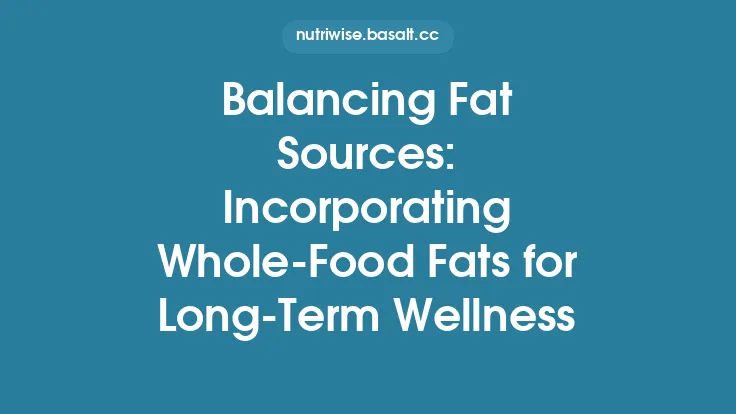Whole grains are more than just a trendy pantry staple; they are a cornerstone of a nutrient‑dense diet that supports long‑term health. By understanding the structure of grains, recognizing quality indicators on packaging, and learning practical ways to weave them into everyday meals, you can make informed choices that boost the nutritional profile of your diet without sacrificing flavor or convenience.
The Anatomy of a Whole Grain: Why It Matters
A true whole grain contains three distinct components that work together to deliver a balanced package of nutrients:
| Component | Primary Nutrients | Functional Role |
|---|---|---|
| Bran | Fiber, B‑vitamins (thiamine, riboflavin, niacin), minerals (iron, magnesium, zinc), antioxidants (phenolic acids) | Provides structural integrity, slows digestion, and contributes to satiety |
| Germ | Healthy fats (including essential fatty acids), vitamin E, B‑vitamins, phytosterols, antioxidants (tocotrienols) | Acts as the embryo of the seed, supplying energy for sprouting; rich in micronutrients |
| Endosperm | Starch, protein, small amounts of B‑vitamins | Supplies the bulk of the grain’s caloric content and serves as a carbohydrate reservoir |
When any of these layers are removed—as occurs in refined flours—the resulting product loses a substantial portion of its fiber, vitamins, minerals, and bioactive compounds. This loss is why whole‑grain options consistently outperform refined counterparts in nutritional assessments.
Health Benefits Backed by Research
Cardiovascular Protection
Whole‑grain consumption has been linked to lower LDL cholesterol and reduced blood pressure. The soluble fiber in bran binds bile acids, prompting the liver to use circulating cholesterol to produce more bile, thereby lowering blood cholesterol levels. Additionally, phytosterols in the germ compete with dietary cholesterol for absorption, further supporting heart health.
Metabolic Advantages
The combination of fiber, protein, and healthy fats in whole grains moderates post‑meal glucose excursions, even though we are not focusing on glycemic index per se. This more gradual rise in blood glucose helps maintain insulin sensitivity over time, decreasing the risk of type 2 diabetes.
Gastrointestinal Well‑Being
Beyond the fiber’s mechanical benefits, whole grains deliver prebiotic compounds such as arabinoxylans and β‑glucans. These fermentable fibers nourish beneficial gut microbes, fostering a diverse microbiome that contributes to immune regulation and nutrient synthesis.
Micronutrient Density
Whole grains are a reliable source of magnesium, selenium, and B‑vitamins—nutrients often lacking in modern diets. Magnesium, for instance, plays a pivotal role in over 300 enzymatic reactions, including those involved in energy production and DNA repair.
Antioxidant and Anti‑Inflammatory Effects
Phenolic acids (e.g., ferulic acid) and tocotrienols present in the bran and germ exhibit antioxidant activity, neutralizing free radicals and attenuating inflammatory pathways. Long‑term intake of these compounds is associated with reduced markers of systemic inflammation.
How to Identify True Whole‑Grain Products
- Read the Ingredient List First
The first ingredient should be a whole grain (e.g., “whole wheat,” “whole oats,” “brown rice”). If the list begins with “enriched wheat flour” or “white rice,” the product is refined.
- Look for Whole‑Grain Stamps
Certifications such as the Whole Grains Council’s “Whole Grain Stamp” provide a quick visual cue. The stamp indicates the amount of whole‑grain content per serving (e.g., 100% whole grain, 50% whole grain).
- Beware of “Multigrain” Labels
“Multigrain” merely means multiple grain types are present; it does not guarantee they are whole. Always verify with the ingredient list.
- Check for Added Sugars and Unnecessary Additives
Some whole‑grain products are heavily sweetened or contain excess sodium and preservatives, which can offset their health benefits.
- Consider the Processing Method
Minimal processing (e.g., stone‑ground, rolled, or flaked) retains more of the grain’s natural nutrients compared to highly refined or pre‑cooked varieties that may have lost fiber and micronutrients during processing.
A Spectrum of Whole‑Grain Options
| Grain | Flavor Profile | Typical Uses | Notable Nutrients |
|---|---|---|---|
| Whole Wheat | Mild, nutty | Breads, pasta, tortillas | B‑vitamins, iron, selenium |
| Brown Rice | Slightly chewy, earthy | Pilafs, stir‑fries, sushi bowls | Magnesium, phosphorus |
| Quinoa | Light, slightly peppery | Salads, side dishes, breakfast porridge | Complete protein, lysine, manganese |
| Barley (hulled) | Chewy, nutty | Soups, stews, grain salads | β‑glucan fiber, selenium |
| Oats (steel‑cut or rolled) | Creamy, sweet | Breakfast cereals, baked goods | β‑glucan, avenanthramides (antioxidants) |
| Millet | Mild, corn‑like | Flatbreads, porridges | Magnesium, phosphorus |
| Sorghum | Sweet, popcorn‑like when popped | Snacks, gluten‑free flours | Iron, phenolic compounds |
| Farro (whole) | Chewy, earthy | Salads, grain bowls | Protein, zinc |
| Teff | Slightly sweet, nutty | Injera, porridges, gluten‑free baking | Calcium, iron, resistant starch |
| Buckwheat | Robust, earthy | Pancakes, soba noodles (check for 100% buckwheat) | Magnesium, rutin (flavonoid) |
Exploring this variety not only prevents palate fatigue but also broadens the spectrum of phytonutrients you receive.
Storage Strategies to Preserve Freshness
- Cool, Dark, and Dry: Store whole grains in airtight containers away from light and heat to prevent oxidation of the germ’s healthy fats.
- Refrigerate or Freeze for Long‑Term Storage: Whole‑grain flours and cracked grains can be kept in the refrigerator for up to six months or frozen for a year without quality loss.
- Rotate Stock: Use a “first‑in, first‑out” system to ensure older grains are consumed before newer ones, minimizing the risk of rancidity.
Practical Tips for Incorporating Whole Grains Into Daily Meals
1. Swap the Base, Not the Flavor
Replace refined rice or pasta with a whole‑grain counterpart in familiar recipes. For example, use brown rice in a stir‑fry, or substitute whole‑wheat spaghetti for regular pasta. The cooking time may be slightly longer, but the flavor remains comforting.
2. Batch‑Cook and Portion
Cook a large pot of a versatile grain (e.g., quinoa, barley, or farro) at the start of the week. Portion into containers for quick add‑ins to salads, soups, or as a side dish. This reduces daily prep time and ensures you always have a wholesome option on hand.
3. Embrace Whole‑Grain Flours
In baking, replace up to 50% of all‑purpose flour with whole‑grain flour (e.g., whole‑wheat, spelt, or oat flour). This boosts fiber and micronutrient content while maintaining a tender crumb. For gluten‑free needs, combine teff, sorghum, and millet flours to mimic the structure of wheat flour.
4. Use Whole Grains as a Crunch Element
Toast whole‑grain cereals, puffed quinoa, or roasted chickpeas to add texture to salads, yogurt bowls, or soups. Lightly seasoning with herbs, spices, or a drizzle of olive oil enhances flavor without adding excessive sodium.
5. Integrate Grains Into Breakfast
Start the day with a warm whole‑grain porridge—steel‑cut oats, millet, or buckwheat—topped with nuts, seeds, and fresh fruit. Overnight soaking reduces cooking time and improves digestibility.
6. Leverage Grain‑Based Snacks
Prepare homemade granola bars using rolled oats, honey, nuts, and dried fruit, or make popcorn‑style popped sorghum for a low‑calorie, high‑fiber snack.
7. Pair Grains with Complementary Proteins
Combine whole grains with legumes (e.g., brown rice and black beans) to create a complete amino acid profile, especially valuable for plant‑based eaters. This synergy also enhances satiety.
8. Mind the Portion Size
A standard serving of cooked whole grains is about ½ cup (≈120 g). Adjust portions based on activity level and overall dietary goals, remembering that the fiber and nutrient density of whole grains can help you feel fuller with less volume.
Cooking Techniques to Maximize Nutrient Retention
- Rinse, Then Soak: Rinsing removes surface dust and some antinutrients. Soaking (30 minutes to overnight, depending on the grain) reduces phytate content, improving mineral bioavailability.
- Use Minimal Water: Cook grains in a 2:1 water‑to‑grain ratio (e.g., 1 cup quinoa to 2 cups water) and bring to a boil, then simmer with the lid on. Excess water can leach water‑soluble B‑vitamins.
- Steam After Cooking: For grains like barley or farro, a brief steam after the water is absorbed helps retain texture and prevents over‑cooking.
- Avoid Over‑Cooking: Prolonged heat can degrade heat‑sensitive nutrients such as certain B‑vitamins and antioxidants. Aim for a tender‑but‑chewy “al dente” texture.
Sustainability and Ethical Considerations
Choosing whole grains can also align with environmental stewardship:
- Lower Processing Energy: Whole grains require fewer processing steps than refined flours, reducing energy consumption and waste.
- Crop Diversity: Incorporating ancient grains (e.g., teff, millet, sorghum) supports agricultural biodiversity, which can improve soil health and resilience to climate change.
- Local Sourcing: Purchasing whole grains from regional producers reduces transportation emissions and often ensures fresher, higher‑quality products.
When possible, look for certifications such as organic, fair‑trade, or regenerative agriculture labels to further support sustainable practices.
Budget‑Friendly Strategies
- Buy in Bulk: Whole grains store well; purchasing larger quantities from bulk bins can lower cost per pound.
- Seasonal Selections: Certain grains may be cheaper during harvest seasons (e.g., oats in late summer). Adjust your grain rotation accordingly.
- DIY Milling: Investing in a small grain mill allows you to purchase whole‑grain kernels and grind them as needed, preserving freshness and reducing packaging waste.
- Utilize Leftovers: Repurpose cooked grains into soups, casseroles, or stuffed vegetables to minimize food waste and stretch your grocery budget.
Sample Meal Plan Illustrating Whole‑Grain Integration
| Meal | Whole‑Grain Component | Complementary Foods |
|---|---|---|
| Breakfast | Steel‑cut oats cooked with almond milk | Sliced banana, chia seeds, cinnamon |
| Mid‑Morning Snack | Popped sorghum (lightly salted) | Handful of mixed nuts |
| Lunch | Quinoa‑based salad with roasted vegetables | Chickpeas, feta cheese, lemon‑herb dressing |
| Afternoon Snack | Whole‑grain rice cakes | Avocado spread, tomato slices |
| Dinner | Farro pilaf with mushrooms and spinach | Grilled salmon, side of steamed broccoli |
| Dessert | Warm whole‑wheat apple crumble (topped with oat flour) | Served with a dollop of Greek yogurt |
This plan demonstrates how whole grains can be seamlessly woven into each eating occasion, delivering consistent nutrient benefits throughout the day.
Common Pitfalls and How to Avoid Them
| Pitfall | Why It Happens | Solution |
|---|---|---|
| Assuming “Multigrain” Equals Whole‑Grain | Marketing focus on variety rather than nutritional quality | Verify the ingredient list; look for “whole” before each grain name |
| Over‑Relying on Pre‑Flavored Packaged Products | Convenience can mask added sugars, sodium, and unhealthy fats | Choose plain whole‑grain bases and flavor them yourself with herbs, spices, or a splash of citrus |
| Neglecting Portion Control | Whole grains are calorie‑dense; large servings can exceed energy needs | Use a kitchen scale or measuring cups to keep portions in check |
| Skipping the Germ | Some “whole‑grain” flours are de‑germed to extend shelf life | Opt for freshly milled or refrigerated whole‑grain flours when possible |
| Cooking at Too High a Temperature | Can cause nutrient loss and uneven texture | Simmer gently and use a tight‑fitting lid to retain moisture and nutrients |
Final Thoughts
Choosing whole‑grain sources is a strategic, evidence‑based approach to enriching your diet with fiber, essential micronutrients, and protective phytochemicals. By mastering how to identify authentic whole‑grain products, diversifying the grains you consume, and applying practical cooking and storage techniques, you can enjoy the taste, texture, and health advantages of whole grains every day. This mindful integration not only supports personal well‑being but also contributes to broader goals of sustainability and food system resilience. Embrace the variety, experiment with preparation methods, and let whole grains become a reliable, nourishing foundation of your macronutrient landscape.





